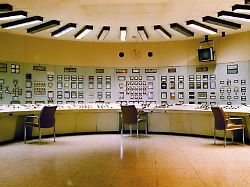Do the lights go out on Sunday?
Numbers, dates, facts about six decades of nuclear power
By Martin Morcinek
04/15/2023 10:48 am
The last three German nuclear power plants go off the grid: With the end of the Isar 2, Emsland and Neckarwestheim 2 reactors, nuclear power generation in Germany is history. What remains after 63 years of nuclear energy? And what will come out of the socket in the future?
Hopes were high, the peaceful use of nuclear energy promised cheap electricity from large central power plants: In 1960 the first German reactor went into operation. A specially created Atomic Energy Act made it possible for the then still young Federal Republic to enter the nuclear age.
The Kahl experimental power plant in Karlstein am Main delivered from 1960 comparatively cheap electricity with an installed capacity of 15 megawatts – after investing billions in research. At the time, proponents of nuclear power did not think about the follow-up costs and the disposal of the radioactive waste. 63 years later, the last three German reactors go offline.
For decades, nuclear energy contributed to supplying Germany as an industrial location with electricity. But nuclear power was never the most important source of energy in Germany. Even at the peak of nuclear power generation, the share was only a good third of annual power generation.
Since the year 2000, the importance has continued to decline. The reason was the gradual shutdown of older reactors. From 2011 – the year of the nuclear catastrophe in Fukushima – renewable energies surpassed nuclear power for the first time. Since then, power generation with solar, wind, geothermal, biomass and hydroelectric power plants has been of greater importance for Germany in terms of energy technology.
Nuclear power plants generate electricity in large quantities regardless of wind and weather conditions. After the first beginnings at the Kahl power plant, a total of 36 further reactors were built in Germany. The list of “nuclear plants”, as they are officially called in official German, contains highly controversial projects.
In addition, there were heavy investment ruins such as the “fast breeder Kalkar” or massively controversial large-scale projects such as the “Wackersdorf reprocessing plant”, which was never completed.
Well-known kiln locations such as Biblis, Brokdorf, Krümmel, Grafenrheinfeld or Mühlheim-Kärlich bring back memories of intense social conflicts and sometimes massive public protests. For decades, the names of once-sleepy towns dominated the main news.
The concrete domes of the reactor building and the cooling towers visible from afar became symbols for the debates about residual risks, investment costs, any incidents, running times and remaining contaminated sites. A look at the actual service life of nuclear power plants raises serious questions: was it worth getting into nuclear power on the bottom line?
The actual operating phase of a typical reactor plant is comparatively short. The Isar 2 nuclear power plant, for example – the most powerful German reactor and at times one of the most profitable reactors in the world – was only connected to the grid for 35 years. The first permit for construction dates back to 1979.
The construction at the Ohu site on the Isar near Landshut seemed uncomplicated: The Isar 2 project was to be built on the site of the predecessor Niederaichbach power plant. However, construction could not start until 1982. On April 9, 1988, the Isar 2 pressurized water reactor fed energy into the German power grid for the first time in commercial operation.
Since then, a total of almost 370,000 gigawatt hours of electricity have been generated in the Isar 2 nuclear power plant. What sounds like a lot is actually not unsurpassable: With the current state of development of wind energy, all German wind turbines would only have to turn for almost three years to arrive at figures of a similar magnitude: In the past year alone, wind turbines in Germany contributed around 123,500 gigawatt hours.
There seems to be enough electricity: the only problem is availability. Unlike nuclear power plants, solar systems and wind turbines do not always provide sufficient electricity when it is actually needed. Storage capacities are limited. So far, the energy suppliers have mainly used pumped storage power plants in order to be able to feed electricity into the grid quickly in times of increased demand.
Even after the nuclear phase-out, there are still enough alternatives that can generate electricity constantly and reliably, regardless of solar radiation and wind strength. Biomass power plants, for example, have consistently provided more energy in recent years than the last remaining nuclear power plants in Germany.
The gap left by the last three miles in the German energy supply does not seem large. Fossil fuels continue to play a far greater role in the German electricity mix: the burning of coal, natural gas and oil is likely to replace the need for plannable energy in the transitional period – with corresponding disadvantages in terms of the climate balance.
Germany is obviously not well prepared: Looking back at the last 23 years of the nuclear phase-out debate, it was not only the rate of expansion of renewables that was far too slow. The realignment of the entire German energy infrastructure and the capacities for converting excess solar and wind power into hydrogen, for example, are still lagging far behind the political course.
And it is still unclear where and how exactly the radioactive waste from six decades of nuclear power generation can be permanently housed. The search for a repository continues. For the “safe enclosure” of fuel rods, reactor walls and other irradiated components, the federal and state governments expect a storage period of around one million years.
All short-term advantages of nuclear energy threaten to fade before the time dimension of this task. Not a single German nuclear power plant has operated for more than 37 years.
